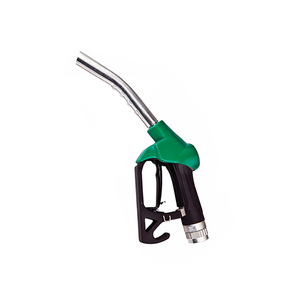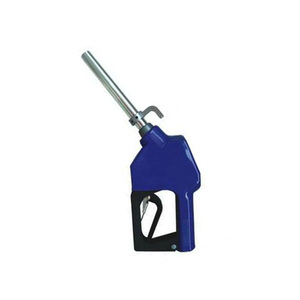(52173 products available)








































































































































































































The fuel pump nozzle comes in various types, each designed to cater to specific needs and applications. Here are some common kinds:
Standard Nozzles
Standard nozzles are the most used type of fuel pump nozzle. They are found in gas stations and are used to dispense gasoline into vehicles. Standard nozzles are designed with automatic shut-off features that prevent overfilling. Additionally, they come in various flow rates to cater to different vehicle types.
Diesel Fuel Nozzle
These nozzles are designed specifically for dispensing diesel fuel. Generally, diesel fuel nozzles have a larger spout compared to gasoline nozzles. This design prevents the diesel from spilling since diesel has a higher viscosity than gasoline. Besides, they are colored green in most countries to differentiate them from gasoline nozzles.
AdBlue Nozzle
An AdBlue nozzle is used to dispense the AdBlue solution, which is injected into the exhaust system of diesel-powered vehicles. This nozzle comes with a distinct design, as its spout is smaller and more precise. The AdBlue nozzle is compatible with the rest of the AdBlue dispensing equipment. Also, it is colored blue to differentiate it from diesel and gasoline nozzles.
High-Flow Nozzles
These are specialized fuel pump nozzles that are commonly used in commercial settings, such as fueling large trucks or airplanes. High-flow nozzles have larger orifices and are designed to dispense fuel at much higher rates compared to standard nozzles. These nozzles reduce the time taken to fuel large vehicles. They also come with safety and automatic shut-off features.
Unleaded Fuel Nozzle
These fuel pump nozzles are used to dispense unleaded gasoline. Unleaded fuel nozzles are designed with a unique feature that makes them incompatible with vehicles that require leaded fuel. For instance, they may come with a smaller size or distinct shape that prevents their connection to the fuel system of leaded fuel vehicles. This feature helps to prevent accidental fueling of leaded fuel into vehicles.
Electric Fuel Pump Nozzle
Electric fuel pump nozzles are used in modern fuel stations that use electronic systems for fuel dispensing. They are controlled electronically, allowing for precise control of the fuel flow rate. Electric fuel pump nozzles are integrated into electronic systems, such as payment processing and fuel management systems.
Fuel Pump Nozzle Shape and Size
Nozzles have different sizes and shapes depending on the application. They can be large or small and have different angles of spray. The shape and size affect how the liquid is dispensed, whether quickly or slowly.
Fuel Pump Nozzle Pressure
Nozzles operate at different pressure levels, such as high or low pressure. The pressure affects how forcefully the liquid is sprayed or flows out. Depending on the application, some require a gentle flow while others need a strong spray.
Automatic Shut-off
Some nozzles have an automatic shut-off feature. When the tank is full or the desired amount is reached, the nozzle automatically stops the flow. This prevents overfilling and reduces spillage.
Fuel Type Compatibility
Different nozzles are designed for various fuel types, such as gasoline, diesel, or biofuels. They are manufactured with materials and internal components that are suitable for specific fuel types to ensure proper flow and prevent corrosion or damage.
Flow Rate Control
Some nozzles have features that allow adjustment of the flow rate. This is useful when dispensing different types of liquids or when precision is required. Users can increase or decrease the flow as needed.
Ergonomics and Ease of Use
Nozzles are designed considering ergonomic factors. They can be lightweight, have comfortable grips, and feature easy-to-use handles or buttons. This ensures convenience and reduces fatigue during prolonged use.
Nozzles are vital components of a fuel dispensing system. Like any other equipment, fuel pump nozzles also require maintenance to avoid damage and ensure long life. Here are some tips on how to maintain a fuel pump nozzle.
When purchasing fuel pump nozzles for sale, consider the following factors:
Application
Consider the intended application when selecting a fuel pump nozzle. Higher flow rates are required for diesel and heavy machinery, whereas smaller vehicles and gasoline require less. Choosing a nozzle compatible with the fuel type and vehicle size is essential.
Flow Rate
The flow rate of a fuel pump nozzle determines how quickly fuel is dispensed into the tank. Higher flow rates reduce refueling time but may lead to overfills in smaller vehicles. Conversely, lower flow rates are more precise but take longer to fuel. Balance the flow rate with the vehicle's requirements for efficient and safe refueling.
Material
Fuel nozzles are often made of stainless steel or plastic. Stainless steel is more durable and corrosion resistant, making it suitable for long-term use in commercial filling stations. Plastic nozzles, on the other hand, are lighter and more affordable but may not last as long as metal ones.
Safety features
Look for safety features such as automatic shut-off valves and anti-drip systems when choosing a fuel pump nozzle. Automatic shut-off valves prevent overfilling by stopping the flow of fuel when the tank is full. Anti-drip systems reduce fuel wastage and environmental pollution by preventing fuel from dripping after use.
Ergonomics
Consider the nozzle's design, handle, and spout shape. An ergonomic fuel pump nozzle is comfortable to hold and easy to aim, ensuring precise fuel delivery. Well-designed nozzles reduce user fatigue and minimize spills.
Compatibility
Ensure the fuel pump nozzle is compatible with existing fuel infrastructure, such as hoses and storage tanks. Proper compatibility prevents leaks and ensures safe and efficient fuel transfer.
Environmental considerations
Some nozzles have features that minimize vapor emissions and fuel spills, reducing their environmental impact. Choosing such nozzles shows commitment to environmental sustainability.
Cost
While not the most important aspect when selecting a fuel pump nozzle, cost cannot be ignored. Compare different nozzles and select one that meets the requirements without breaking the bank.
It is advisable that the fuel pump nozzle be replaced by a professional to avoid further damage to the vehicle. However, it can be replaced as long as the right steps are followed. Before replacing the fuel pump nozzle, make sure the following tools are at hand.
After getting the right tools, follow the steps below to replace the car's fuel pump assembly.
Q1: How does one know a defective fuel pump nozzle?
A1: There are several signs of a defective fuel pump nozzle. One of them is fuel spilling or gushing out when one is refueling. The fuel pump nozzle may also display an error message when there is no issue. Another sign is the user having to hold the handle to keep fuel pumping, or the fuel pump nozzle keeps clicking off.
Q2: Can one repair a fuel pump nozzle?
A2: It is not advisable to repair a fuel pump nozzle. Users should replace any damaged or worn-out nozzles since they are inexpensive and easy to install.
Q3: What is the difference between a manual and an automatic fuel pump nozzle?
A3: A manual fuel pump nozzle requires the user to hold the handle until the tank is full. In contrast, an automatic fuel pump nozzle automatically switches off when the tank is full, requiring the user to hold the handle until the tank is full.
Q4: What is a click-on fuel pump nozzle?
A4: A click-on fuel pump nozzle is a type of automatic fuel pump nozzle. It gets its name from the clicking sound it makes when the tank is full. It signals the user to stop fueling.
Q5: What are the different types of fuel pump nozzles?
A5: There are several types of fuel pump nozzles. They include the following: automatic nozzles, manual nozzles, and locking fuel nozzles. Others are diesel nozzles, AdBlue nozzles, and high-flow nozzles.